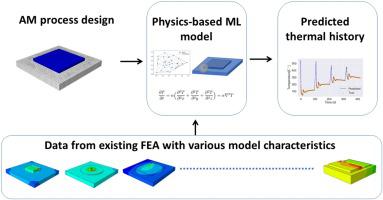Journal of Materials Processing Technology ( IF 6.7 ) Pub Date : 2021-12-30 , DOI: 10.1016/j.jmatprotec.2021.117472 Kari Lovise Ness 1 , Arindam Paul 2 , Li Sun 1 , Zhiliang Zhang 1

|
Additive manufacturing (AM) is an emerging manufacturing technology that constructs complex parts through layer-by-layer deposition. The prediction and control of thermal fields during production of AM parts are of crucial importance as the temperature distribution and gradient dictates the microstructures, properties, and performance. Finite element (FE) analyses are commonly conducted to simulate the thermal history of the AM process, but are known to be costly and time-consuming. This paper aims to address the challenge by presenting the essential components of a generic data-driven control framework. The proposed framework utilizes extremely randomized trees and is trained and tested on datasets generated through FE simulations. The datasets contain generic, engineered features constructed based on the physics of the underlying thermal process. The features are transferable between a wide range of cases and have achieved mean absolute percentage errors (MAPE) below 2.5% for predicting nodal temperature profiles. In addition, predictions of entire simulations with machine learning (ML) models trained on datasets from different cases have been conducted with MAPE below 5%. The results demonstrate the transferability of thermal histories between several geometries and significantly reduce the need for expensive FE simulations. We believe that these findings are an important step towards real-time optimization in AM.
中文翻译:

面向增材制造中几何不变热历史预测的通用基于物理的机器学习模型
增材制造 (AM) 是一种新兴的制造技术,它通过逐层沉积来构造复杂的零件。由于温度分布和梯度决定了微观结构、性能和性能,因此在 AM 零件生产过程中对热场的预测和控制至关重要。有限元 (FE) 分析通常用于模拟增材制造工艺的热历史,但众所周知,这种分析既昂贵又耗时。本文旨在通过介绍通用数据驱动控制框架的基本组件来应对这一挑战。所提出的框架利用了极其随机的树,并在通过 FE 模拟生成的数据集上进行了训练和测试。数据集包含基于底层热过程物理构造的通用工程特征。这些特征可以在广泛的情况下转移,并且在预测节点温度剖面时已实现低于 2.5% 的平均绝对百分比误差 (MAPE)。此外,在 MAPE 低于 5% 的情况下,使用机器学习 (ML) 模型对来自不同案例的数据集进行训练的整个模拟进行了预测。结果证明了几种几何形状之间热历史的可转移性,并显着减少了对昂贵的有限元模拟的需求。我们相信这些发现是实现 AM 实时优化的重要一步。使用在不同案例的数据集上训练的机器学习 (ML) 模型对整个模拟进行预测,MAPE 低于 5%。结果证明了几种几何形状之间热历史的可转移性,并显着减少了对昂贵的有限元模拟的需求。我们相信这些发现是实现 AM 实时优化的重要一步。使用在不同案例的数据集上训练的机器学习 (ML) 模型对整个模拟进行预测,MAPE 低于 5%。结果证明了几种几何形状之间热历史的可转移性,并显着减少了对昂贵的有限元模拟的需求。我们相信这些发现是实现 AM 实时优化的重要一步。









































 京公网安备 11010802027423号
京公网安备 11010802027423号